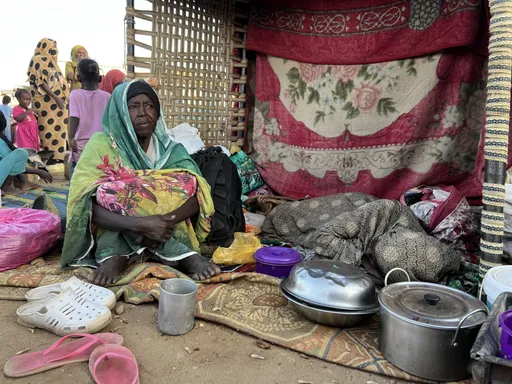By Mazhun Idris
One of the highlights of Turkish First Lady Emine Erdogan's recent visit to Nigeria was a painting exhibition hosted by Abuja's Yunus Emre Institute, showcasing the works of some of the West African nation's accomplished women artists.
Among the artists whose works graced the exhibition hall was Halima Abubakar, a practitioner of distinct art forms whose multicultural origins are as fascinating as the delicate brushstrokes that left the Turkish First Lady delighted and intrigued.
"My art forms of choice are Mandala, Tezhip and Dotilism," Halima tells TRT Afrika.
Tezhip is a Turkish word meaning "ornamenting with gold". In Ottoman Turkish, it was the creative tradition of beautifying calligraphy and decorative illumination of manuscripts using various inks and brushstrokes.
In mosques and religious centres, Tezhip works incorporate the archetypal Islamic star patterns, made up of geometric and parametric strokes forming a complex series of intertwining designs reflecting Middle Eastern traditions.
Mandala, on the other hand, is a Sanskrit word for "circle". It is an art form that employs geometric designs and patterns, which originally symbolise the universe in Hinduism and Buddhism and a gateway to inner peace in meditation.
Dotilism, as the name suggests, is an art form that involves layering countless dots on a surface to create texture and depth before using colours to create unique works matching the beauty of ornamental tiling.
The placement of dots follows symmetrical interactions of colour to achieve concordance, blending, shade, and gradient. Dot art could be on a canvas, a ceramic tea mug, vase, wall, or floor.
Passion project
Halima's creative journey started a decade ago when she chanced upon Mandala art on Instagram. She was 18 then and a student at Bayero University in Kano, northwest Nigeria, where she majored in biochemistry.
"I reached out to professionals in Dubai and India, among other Asian countries, for their insights into this art form that I found so interesting. But there was no response from any of them," says Halima, reminiscing about her spur-of-the-moment decision.
She searched for Mandala artists in Nigeria who could teach her the basics but found none then.
Undaunted, Halima took it upon herself to self-study, watching online videos and reading DIY blogs over the next three years. To create Mandala art, she used colour pencils, a medicine dropper, cotton swabs, and broomsticks.
"I went through a long process of self-learning and practising until I became good at it," she tells TRT Afrika.
Halima became a professional artist in late 2017, when she was only 21.
For her artistic prowess in this tediously intricate craft, Halima credits her natural trait of attention to detail and love of precision and uniformity. She says this holds her in good stead even when things get difficult.
African flair
As Mandala is linked to Eastern spirituality and meditation, Halima thought of how best to infuse elements of African motifs into this foreign art form while maintaining its authenticity.
"I decided to spice it up with an African touch, using patterns and forms to create a piece representing contemporary art from the continent. There is no limit to what one can create," she says.
With her localisation of these art forms, Halima has a clientele of high-profile corporate and private clients on a lengthening waiting list.
Her bespoke murals have a distinctly local touch, featuring everything from mosques to Nigeria's presidential complex.
Meditative process
So, how intricate is the artistic process that goes into Halima's Mandala designs? "Mastering this art technique requires precision, consistency, and patience. You also need a specialised Dotilism toolkit," she explains.
Mandala designs must be painted on an even surface, a canvas or a wall. Halima's first step for mural projects is a site visit to survey, scale, and map out the design schema and determine a suitable colour palette.
On a typical workday, she arrives at a site with her team, who would prime the surface and add a base coating to ensure the murals come to life.
The creative team would then plot regular outlines of the preliminary sketches, with intricate hand-drawn patterns, aiming to complete the symmetry of each Mandala or Tezhip element in proportion to the background.
"I will then fill in the details with colours, trying to stick to the theme and my predetermined concepts. Occasionally, I follow spontaneous inspirations and incorporate imperfections," Halima tells TRT Afrika.
She works seated or standing on a prop or a ladder, depending on need. With her keen eyes, she is often lost in her enchanting work, immersed in the soothing process as though in meditation.
"Beyond motivation, Dotilism art is a time-consuming venture that requires a great deal of patience, discipline, mindfulness, deep passion, and cultivated calmness," she says.
Around Abuja and many Nigerian states, Halima's Tezhip murals and mandala artworks have transformed public and private spaces, even as they spark conversations and the feeling of harmony and beauty.
➤ Click here to follow our WhatsApp channel for more stories.




















